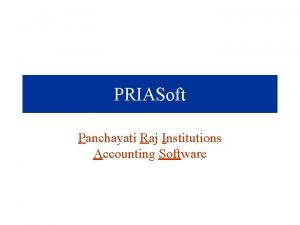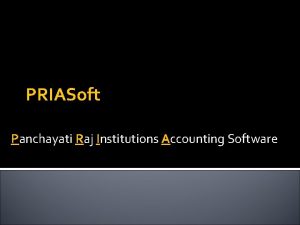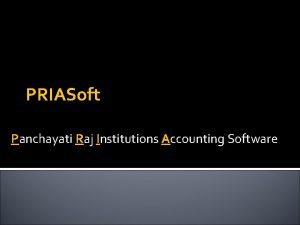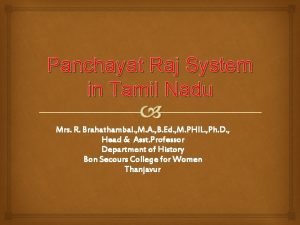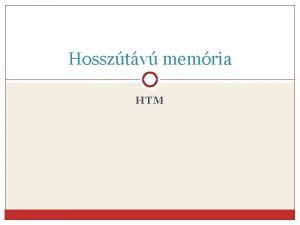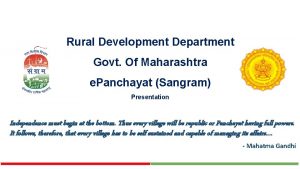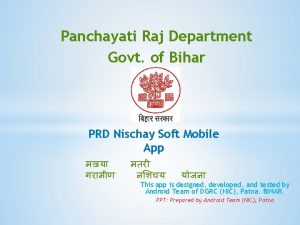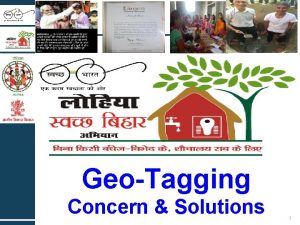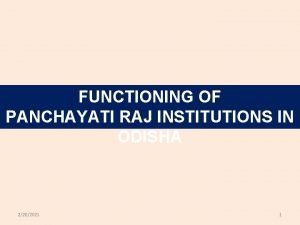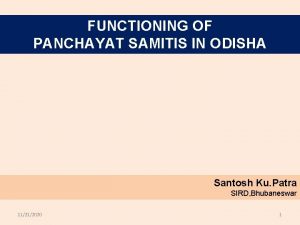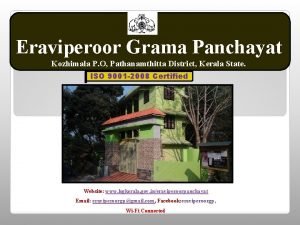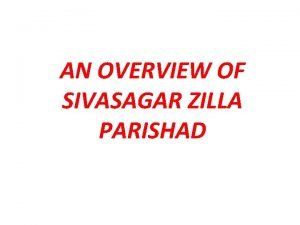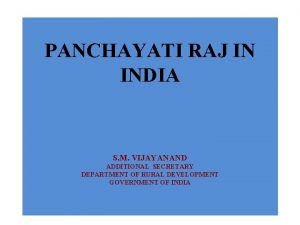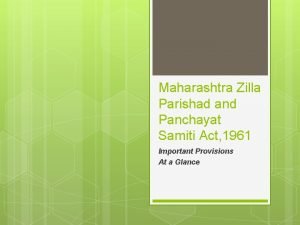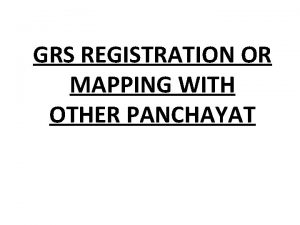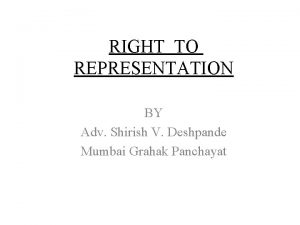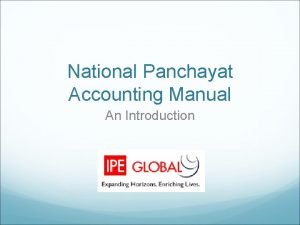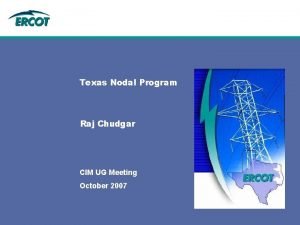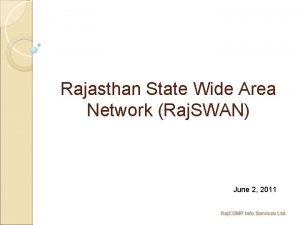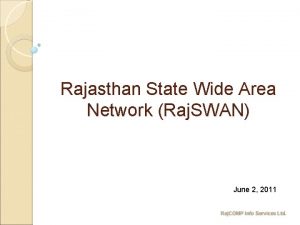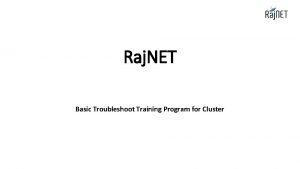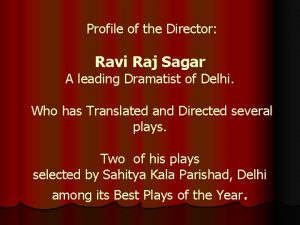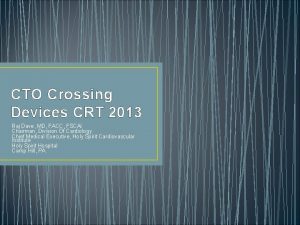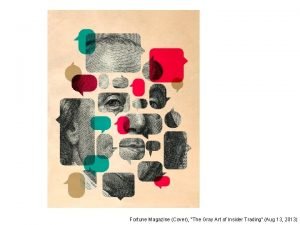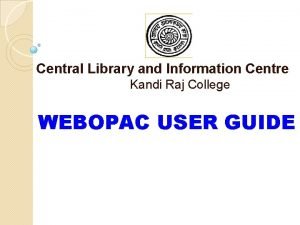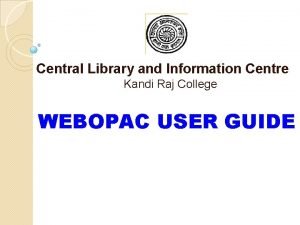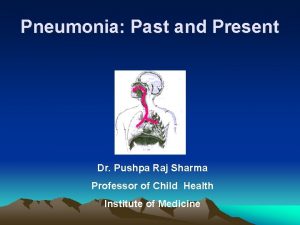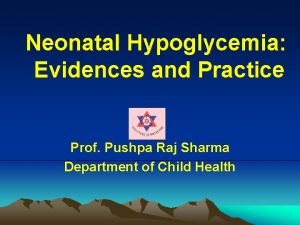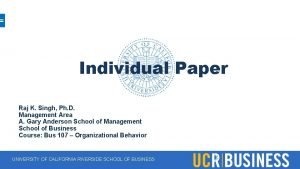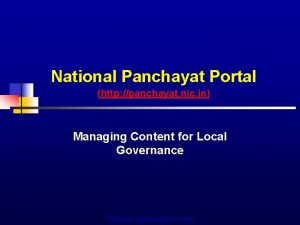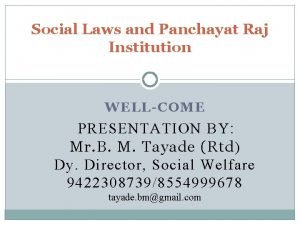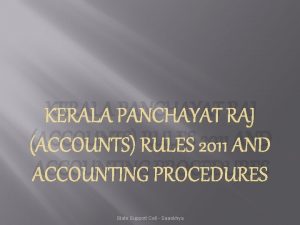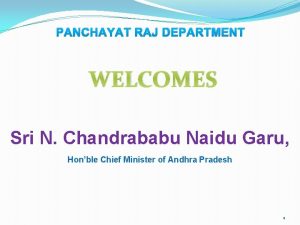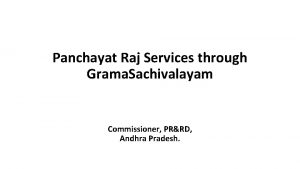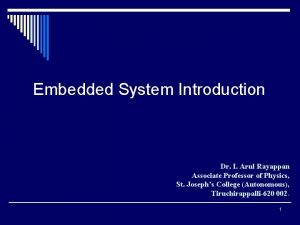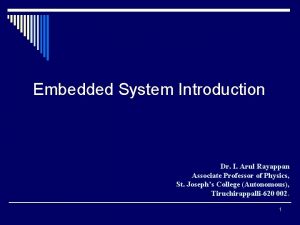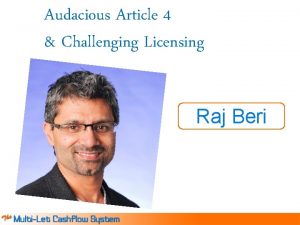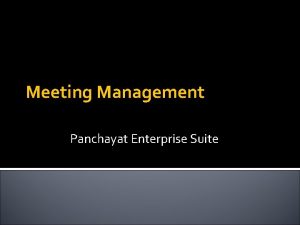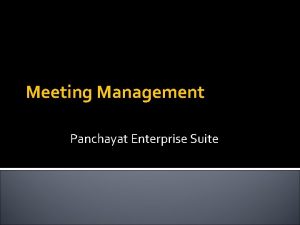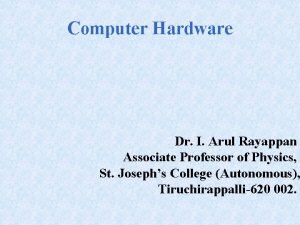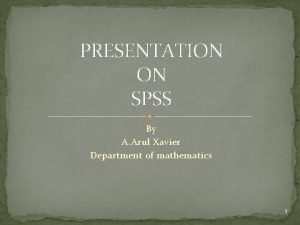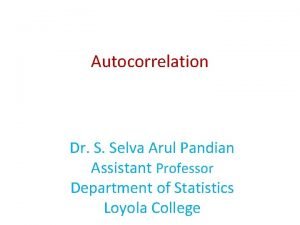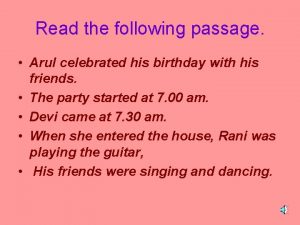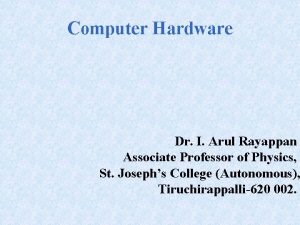PANCHAYAT RAJ SYSTEM P W JEYAKUMAR ARUL M















































- Slides: 47

PANCHAYAT RAJ SYSTEM P. W. JEYAKUMAR ARUL M. Sc. , M. B. A. , M. A. , (Human Rights), L. L. B. , ADVOCATE, CHENNAI. 9444055656.

Concept • The word raj means "rule" and panchayat means "assembly" (ayat) of five (panch). • Mahatma Gandhi advocated panchayat raj as the foundation of India's political system. • Each village would be responsible for its own affairs

Late History • A new class of feudal chiefs and revenue collectors (zamindars) emerged between the ruler and the people. • "The panchayat was destroyed by the East India Company when it was granted the office of Diwan in 1765 in Bengal by the Mughal Emperor as part of reparation after his defeat at Buxar. • The Patwari became the official record keeper for a number of villages. • The second was the creation of the office of magistrate and the abolition of village police.

Ripon • Lord Ripon who, in his famous resolution on local self-government on May 18, 1882, recognized the twin considerations of local government: (i) administrative efficiency and (ii) political education. • The Ripon Resolution, which focused on towns, provided for local bodies consisting of a large majority of elected non-official members and presided over by a non-official chairperson. • This resolution met with resistance from colonial administrators.

Constitution • Article 40. The Article read 'the State shall take steps to organize village panchayats and endow them with such powers and authority as may be necessary to enable them to function as units of self-government'. • However, no worthwhile legislation was enacted either at the national or state level to implement it.

Balwant Rai Mehta • 1956, the National Development Council appointed a committee under Balwant Rai Mehta, which submitted its report in 1957 in which it recommended: - A 3 -tier structure consisting of Zila Parishad at the District level, Panchayat Samiti at the Block level and Gram. Panchayat at the village level. • the Panchayati Raj Act (73 rd Amendment) in 1992, In the history of Panchayati Raj, in India, on 24 April 1993, the Constitutional (73 rd Amendment) Act 1992 came into force to provide constitutional status to the Panchayati Raj institutions.

Features The main features of this act are: • (a) a 3 -tier system of Panchayati Raj for all States having population of over 20 lakh; • (b) Panchayat elections regularly every 5 years; • (c) reservation of seats for Scheduled Castes, Scheduled Tribes and women (not less than one-third of seats); • (d) appointment of State Finance Commission to make recommendations as regards the financial powers of the Panchayats. • Hence, in theory, panchayats have been given sufficient authority to function as institutions of selfgovernance and aid social justice.


Adoption • The Panchayat Raj system was first adopted by the state of Rajasthan in Nagaur district on 2 nd Oct 1959. The second state was Andhra Pradesh, • National Panchayati Raj Day of India celebrated by Ministry of Panchayati Raj on 24 April annually.

Features of 73 rd Amendment Act 1992 • The 73 rd Amendment to the Constitution enacted in 1992 added a new part-IX to the Constitution. It also added a new XI schedule containing list of 29 functional items for Panchyats and made statutory provisions for the establishment, empowerment and functioning of Panchayati Raj institutions. Some provisions of this amendment are binding on the States, while others have been left to be decided by respective State Legislatures at their discretion.

Features The salient features of this amendment are as follows: • Organization of Gram Sabhas; • Creation of a threetier Panchayati Raj Structure at the District (Zila), Block and Village levels; • Almost all posts, at all levels to be filled by direct elections; • Minimum age for contesting elections to the Panchayati Raj institutions be twenty one years; • The post of Chairman at the District and Block levels should be filled by indirect election; • There should be reservation of seats for Scheduled Castes/ Scheduled Tribes in Panchayats, in proportion to their population, and for women in Panchayats up to one -third seats; • State Election Commission to be set up in each State to conduct elections to Panchayati Raj institutions; • The tenure of Panchayati Raj institutions is five years, if dissolved earlier, fresh elections to be held within six months; and • a State Finance Commission is to be set up in each State every five years.

Some of the provisions, which are not binding on the States, but are only guidelines: • Giving representation to the members of the Central and State legislatures in these bodies; • Providing reservation for backward classes; and • The Panchayati Raj institutions should be given financial powers in relation to taxes, levy fees etc. and efforts shall be made to make Panchayats autonomous bodies.

1. Village Panchayat: 2. Block Panchayat : 3. District Panchayat:

Eligibility • Registered as voters • Not hold any office of profit • Persons not convicted by the court for criminal offences • Provision for co-option of two women • One member of the Scheduled Castes and Scheduled Tribes

Gram Sabha • Panchayat as a body is accountable to the general body of the village known as Gram Sabha which meets at least twice a year. • Panchayat has to secure the latter’s approval of the village production plan, proposals for taxation and development programmes before they are enforced by the Panchayat.

Panchayat President • Every Panchayat elects a President or Sarpanch and a Vice-President • He acts as the executive head of the Panchayat, represents it in the Block Panchayat as its spokesman and coordinates its activities and those of other local institutions like cooperatives • The Panchayat Secretary and the Village Level Worker are the two officers at the Panchayat level to assist the president in administration.

Functions • Panchayat Secretary assists the Panchayat in recording decisions, keeping minutes, preparing budget estimates and reports, and does other sundry jobs like preparing notices, explaining circulars, organising Gram Sabha meetings etc. • Village Development Officer assists the Panchayat in drawing up agricultural production plans, helps farmers in securing loans for agriculture, arranges the supply of inputs like seeds and fertilizers, and educates farmers about modern agricultural practices.

• Principal functions • The Panchayat also performed by the keeps records of births Village Panchayat, they and deaths. include maintenance of • roads, wells, schools, burning and burial grounds, sanitation, public health, libraries, reading rooms, community centre etc.

Popular Schemes

The Gram Panchayats can levy certain taxes and duties to meet their expenses.

• They have to depend on the state government for further finances.

Block Panchayat • Consists of 20 to 60 villages depending on area and population. The average population under a Samiti is about 80, 000 but the range is from 35, 000 to 1, 000. • The President of the Block Panchayat is the Pradhan, who is elected by an electoral college which consists of all members of the Block Panchayat and all the Presidents of the Gram Panchayat falling within the areas. • He exercises administrative control over the Vikas Adhikari (BDO) and his staff. He is a member of the Zilla Parishad by virtue of his office as a Pradhan. He is the ex- officio chairman of the Standing Committees of the Block.

Composition • The Block Panchayat generally consists of- (1) about twenty members elected by and from the Heads of all the Panchayats falling in the block area; (2) two women members and one member each from the Scheduled Castes and Scheduled Tribes to be coopted, provided they do not get adequate representation otherwise; • (3) two local persons possessing experience of public life and administration, which may be beneficial for the rural development; (4) representatives of the Co-operatives working within the jurisdiction of the block; (5) one representative elected by and from the members of each small municipality lying within the geographical limits of a block; (6) the members of the State and Union legislatures representing the area are to be taken as associate members.

Block Development Officer • As the Chief Executive Officer of the Block Panchayat , the Block Development Officer is entrusted with the responsibility for implementing the resolutions of the Block and its Standing Committees. Preparing the annual report of the Block and sending it to the Zilla Parishad and State Government also comes within the purview of his responsibility. He is accountable to the President of the Block for his actions.

Departments The common departments in the Block are as follows: • • • General Administration Finance Public Works Agriculture Health Education Social Welfare Information Technology Water Supply Department Animal Husbandry and others

Functions • Implementation of schemes for the development of agriculture and infrastructure • Establishment of primary health centres and primary schools • Supply of drinking water, drainage and construction/repair of roads • Development of a cottage and small-scale industries, and the opening of cooperative societies • Establishment of youth organisations

• The Block Panchayat supervises the work of the Panchayover the elected members amounts to a mockery of democracy so far as democratic decentralisation is concernedats and scrutinises their budgets. • It has no independence in instituting special programmes or development projects of its choice. It simply carries out the directives of the State Government pertaining to specific projects. • Furthermore, the primacy of the non-elected members of the Block

District (Zilla) Panchayat • Zilla Parishad consists of representatives of the Block Panchayat ; all the members of the State Legislature and the Parliament representing a part or whole of the district; all district level officers of the Medical, Public Health, Public Works, Engineering, Agriculture, Veterinary, Education and other development departments. • There is also a provision for special representation of women, members of Scheduled Castes and Scheduled Tribes provided they are not adequately represented in the normal course. • The Collector is also a member of the Zilla Parishad.

Chairman & Functions • The Chairman of the Zilla Parishad is elected from among its members. There is a Chief Executive Officer in the District Panchayat. • The , District Panchayat for the most part, performs coordinating and supervisory functions. • The District Panchayat also renders necessary advice to the Government with regard to the implementation of the various development schemes. It is also responsible for the maintenance of primary and secondary schools, hospitals, dispensaries, minor irrigation works etc. It also promotes local industries and art.

Functions • Provide essential services and facilities to the rural population • Supply improved seeds to farmers and inform them of new farming techniques • Set up and run schools and libraries in rural areas • Start primary health centers and hospitals in villages; start vaccination drives against epidemics • Execute plans for the development of the scheduled castes and tribes; run ashram shalas for Adivasi children; set up free hostels for them. • Encourage entrepreneurs to start small-scale industries and implement rural employment schemes. • Construct bridges, roads and other public facilities and their maintenance • Provide employment.

Finance & Meetings • The finances of the District Panchayat consist of the grants received from the State Government and share in the land cess and other local cess and taxes. • District Panchayat meetings are conducted once a month. Special meetings can also be convened to discuss special matters. Subject committees are also formed

Types of Urban Local Government There are eight types of urban local governments currently existing in India: • • Municipal Corporations. Municipality. Notified area committee. Town area committee. Cantonment board. Township. Port trust. Special purpose agency.

Decentralisation • DECENTRALISATION OF TRANSFER OF POWERS DECENTRALISATION OF TRANSFER OF FUNDS DECENTRALISATION OF PERSONNEL Decentralisation is the only key for strengthening Panchayati Raj Institutions.

Corruption • However, like any system in the world, this system is also imperfect. • Problems of maladministration and misappropriation of funds are recurring. But this shall not stand in the way of efficient governance; and if these ill practices are rooted out, there would be no comparisons around the world to our system of local selfgovernment.












Summary • To conclude, local self-government is one of the most innovative governance change processes our country has gone through. The noble idea of taking the government of a country into the hands of the grass root level is indeed praiseworthy.

 Arul edison anthony raj
Arul edison anthony raj What is the theme of the holy panchayat
What is the theme of the holy panchayat Priasoft head
Priasoft head Priasoft
Priasoft Panchayati raj institutions accounting software (priasoft)
Panchayati raj institutions accounting software (priasoft) G. v. k. rao committee
G. v. k. rao committee John arul
John arul Recencia hatás
Recencia hatás What is panchayat
What is panchayat E panchayat maharashtra
E panchayat maharashtra Panchayat nischay soft bihar
Panchayat nischay soft bihar Geo-tagging in panchayat
Geo-tagging in panchayat Panchayati raj
Panchayati raj Odisha panchayat samiti accounting procedure rules 2002
Odisha panchayat samiti accounting procedure rules 2002 Eraviperoor grama panchayat
Eraviperoor grama panchayat Ambika kumari
Ambika kumari Panchayat structure
Panchayat structure Maharashtra zp and ps act 1961
Maharashtra zp and ps act 1961 Grs in gram panchayat
Grs in gram panchayat Shirish deshpande mumbai grahak panchayat
Shirish deshpande mumbai grahak panchayat National panchayat accounting manual
National panchayat accounting manual Ramraj institute nashik
Ramraj institute nashik Raj chudgar
Raj chudgar Rajswan
Rajswan Raj swan
Raj swan Rajnet
Rajnet Ravi raj sagar
Ravi raj sagar Raj thakkar
Raj thakkar Raj singamsetti
Raj singamsetti Dr pushpa raj sharma
Dr pushpa raj sharma Raj dave md
Raj dave md Asha pabla
Asha pabla Webopac uom
Webopac uom Webopac uom
Webopac uom Raj rani vs prem adib case summary
Raj rani vs prem adib case summary Dr pushpa raj sharma pediatrician
Dr pushpa raj sharma pediatrician Raj web service
Raj web service Azharul raj
Azharul raj Raj kumari amrit kaur coaching scheme
Raj kumari amrit kaur coaching scheme Pushpa raj sharma
Pushpa raj sharma Kumar raj kharel
Kumar raj kharel Dr pushpa raj sharma clinic
Dr pushpa raj sharma clinic Raj k. khanna
Raj k. khanna Raj k singh
Raj k singh Jcurv
Jcurv Dr kavita raj
Dr kavita raj Raj johnson
Raj johnson Dr pushpa raj sharma pediatrician
Dr pushpa raj sharma pediatrician


